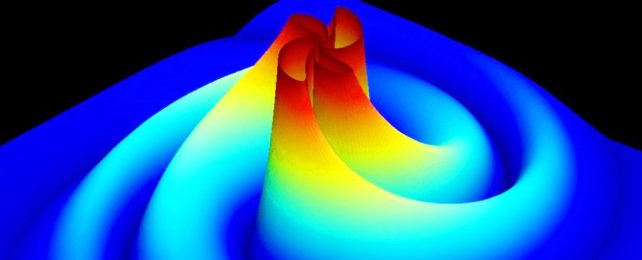The ripples in space-time generated by colliding black holes have taught us a lot about these enigmatic objects.
These gravitational waves encode information about black holes: their masses, the shape of their inward spiral towards each other, their spins, and their orientations.
From this, scientists ascertained that most of the collisions we've seen have been between black holes in binary systems. The two black holes started as a binary of massive stars that turned into black holes together, then spiraled in and merged.
Of the 90 or so mergers detected so far, however, one stands out as very peculiar. Detected in May 2019, GW19052 emitted space-time ripples like no other.
"Its morphology and explosion-like structure are very different from previous observations," says astrophysicist Rossella Gamba of the University of Jena in Germany.
She adds, "GW190521 was initially analyzed as the merger of two rapidly rotating heavy black holes approaching each other along almost circular orbits, but its special features led us to propose other possible interpretations."
In particular, the short, sharp duration of the gravitational wave signal was challenging to explain.
Gravitational waves are generated by the actual merger of two black holes, like ripples from a rock dropped into a pond. But they're also generated by the binary inspiral, and the intense gravitational interaction sends out weaker ripples as two black holes move inexorably closer.
"The shape and brevity – less than a tenth of a second – of the signal associated with the event lead us to hypothesize an instantaneous merger between two black holes, which occurred in the absence of a spiraling phase," explains astronomer Alessandro Nagar of the National Institution for Nuclear Physics in Italy.
There's more than one way to end up with a pair of black holes gravitationally interacting.
The first is that the two were together for a long time, perhaps even from the formation of baby stars from the same piece of molecular cloud in space.
The other is when two objects moving through space pass each other closely enough to get snagged gravitationally in what is known as a dynamical encounter.
This is what Gamba and her colleagues thought might have happened with GW190521, so they designed simulations to test their hypothesis. They smashed together pairs of black holes, tweaking parameters such as trajectory, spin, and mass, to try to reproduce the weird gravitational wave signal detected in 2019.
Their results suggest that the two black holes did not start out in a binary but were caught in each other's gravitational web, tumbling past each other twice on a wild, eccentric loop before slamming together to form one larger black hole. And neither of the black holes in this scenario was spinning.
"By developing precise models using a combination of state-of-the-art analytical methods and numerical simulations, we found that a highly eccentric merger in this case explains the observation better than any other hypothesis previously put forward," says astronomer Matteo Breschi of the University of Jena.
"The probability of error is 1:4,300!"
This scenario, the team says, is more likely in a densely populated region of space, such as a star cluster, where such gravitational interactions are more likely.
This tracks with previous discoveries about GW190521. One of the black holes in the merger was measured at around 85 times the mass of the Sun.
According to our current models, black holes over 65 solar masses can't form from a single star; the only way we know a black hole of that mass can form is through mergers between two lower-mass objects.
The work of Gamba and her colleagues found that the masses of the two black holes in the collision sit at around 81 and 52 solar masses; that's slightly lower than previous estimates, but one of the black holes is still outside the single star core collapse formation pathway.
It's still unclear if our models need tweaking, but hierarchical mergers – whereby larger structures form through the continuous merging of smaller objects – are more likely in a cluster environment with a large population of dense objects.
Dynamical encounters between black holes are considered pretty rare, and the gravitational wave data collected by LIGO and Virgo to date would seem to support this. However, rare doesn't mean impossible, and the new work suggests that GW190521 may be the first we've detected.
And a first means that there could be more in the years ahead. The gravitational wave observatories are currently being upgraded and maintained but will come online again in March 2023 for a new observing run. This time, LIGO's two detectors in the US and the Virgo detector in Italy will be joined by KAGRA in Japan for even more observing power.
More detections like GW190521 would be amazing.
The research has been published in Nature Astronomy.
